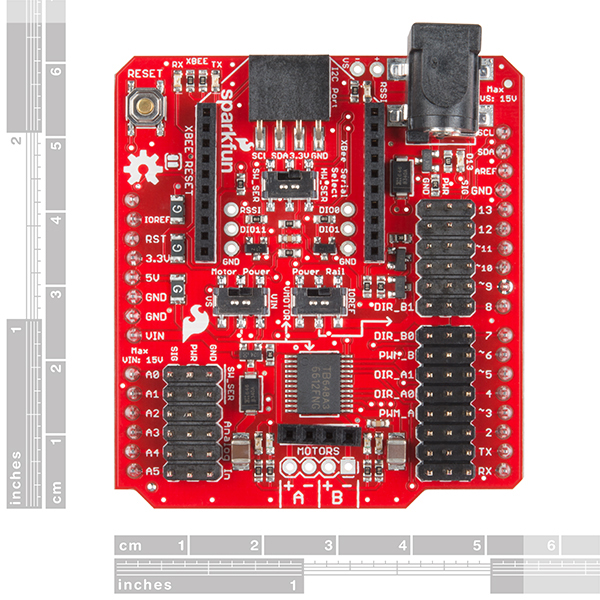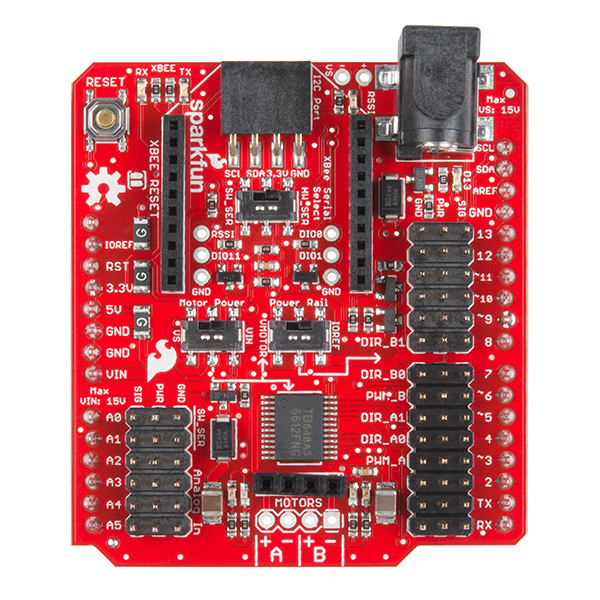SparkFun Wireless Motor Driver Shield
The SparkFun Wireless Motor Driver Shield is designed to make connecting motors, sensors and other components to your Arduino-based project as fast and easy as possible. The heart of the Wireless Motor Driver Shield is the Toshiba TB6612FNG H-Bridge Motor Driver, which allows the shield to control two DC motors at once, both CW and CCW, and to brake electronically. The TB6612FNG H-Bridge is rated up to 1.2A per channel at 13V, which means it will drive a fair variety of hobby motors ranging in power. Each of the GPIO pins is broken out on a “servo-style” header field with PWR and GND to allow you to easily connect devices using a 3-pin servo cable.
Using the onboard slide switches, the motor power and servo power rail can be connected to the Arduino's regulated voltage, VIN, or a completely separate power supply attached to the shield's barrel jack. This feature makes the SparkFun Wireless Motor Driver Shield ideal if you are connecting multiple servos and need more than 5V to your robotics project!
This shield also includes an I2C pin-out and a built-in XBee socket, making it perfect for setting up an XBee-based remote control. Simply plug an XBee module into the socket on the shield, and you have the control system for a simple remote control rover or small autonomous robot!
- TB6612FNG H-Bridge Motor Driver
- XBee Socket
- I2C Header
- Arduino R3 Layout
- Schematic
- Eagle Files
- Hookup Guide
- Datasheet (TB6612FNG)
- GitHub
SparkFun Wireless Motor Driver Shield Product Help and Resources
Wireless Motor Driver Shield Hookup Guide
August 17, 2017
Get started with the SparkFun Wireless Motor Driver Shield!
Wireless RC Robot with Arduino and XBees
March 12, 2019
In this tutorial, we will expand on the SIK for RedBot to control the robot wirelessly with XBee radios! We'll explore a different microcontroller and wirelessly control the RedBot at a distance.
Core Skill: Robotics
This skill concerns mechanical and robotics knowledge. You may need to know how mechanical parts interact, how motors work, or how to use motor drivers and controllers.
Skill Level: Rookie - You will be required to know some basics about motors, basic motor drivers and how simple robotic motion can be accomplished.
See all skill levels
Core Skill: Programming
If a board needs code or communicates somehow, you're going to need to know how to program or interface with it. The programming skill is all about communication and code.
Skill Level: Rookie - You will need a better fundamental understand of what code is, and how it works. You will be using beginner-level software and development tools like Arduino. You will be dealing directly with code, but numerous examples and libraries are available. Sensors or shields will communicate with serial or TTL.
See all skill levels
Core Skill: Electrical Prototyping
If it requires power, you need to know how much, what all the pins do, and how to hook it up. You may need to reference datasheets, schematics, and know the ins and outs of electronics.
Skill Level: Competent - You will be required to reference a datasheet or schematic to know how to use a component. Your knowledge of a datasheet will only require basic features like power requirements, pinouts, or communications type. Also, you may need a power supply that?s greater than 12V or more than 1A worth of current.
See all skill levels
Comments
Looking for answers to technical questions?
We welcome your comments and suggestions below. However, if you are looking for solutions to technical questions please see our Technical Assistance page.
Customer Reviews
4.5 out of 5
Based on 2 ratings:
Nice
Works
Works exactly as described
However, I wish it hadn't dedicated Arduino pin 3 to the motor driver, thus unnecessarily tying up one of the interrupt-enabled pins. Otherwise perfect for its intended use.





